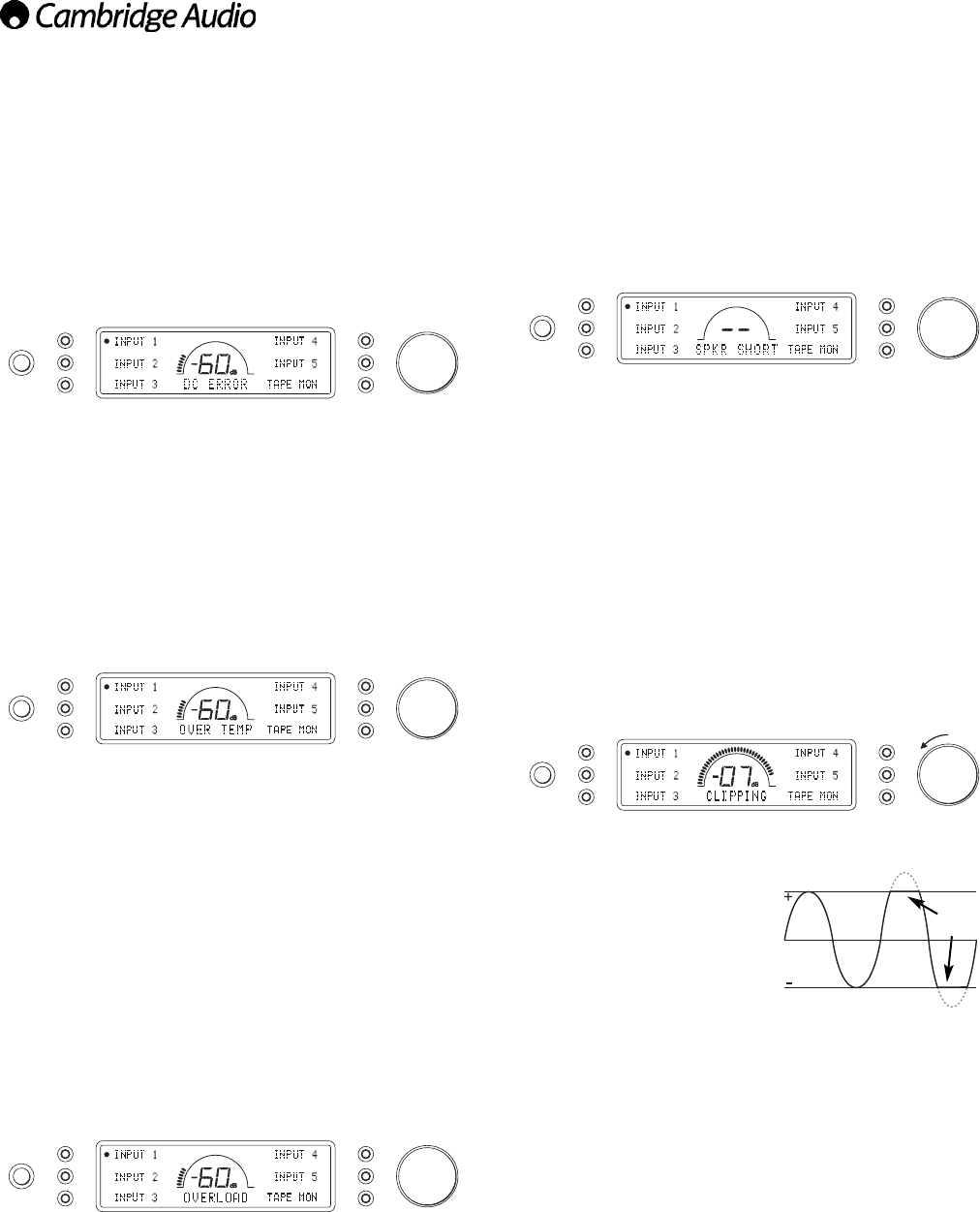
12
CAP5 - Fiveway protection system
Cambridge Audio has developed a proprietary protection system to
ensure reliability and a long life for its amplifiers and the speakers they
are connected to.
Note:
Due to the required sensitivity of the CAP5
system, it is possible that mains power disturbances can falsely trigger
CAP5 in extreme situations. This protection system comprises of five
main protection methods:
1. DC detection
Indication - Unit has switched off during operation, display flashes “DC
ERROR”.
Description - CAP5 offers loudspeaker protection if the output of the
amplifier goes to a high constant voltage (DC) because of some internal
fault. This is a rare fault although detecting it could just save those
expensive loudspeakers.
Remedy - Due to the necessary sensitivity of the DC protection circuit,
extremely hard clipping of the amplifier may cause DC protection to be
triggered. If this fault occurs please switch the unit off, power up again
and check operation with a reduced volume level. If the DC fault occurs
again please contact your dealer for service.
2. Over temperature detection
Indication - Unit has switched off during operation, display flashes
“OVER TEMP”.
Description - Over temperature is caused by a combination of high
listening levels and low impedance speakers. CAP5 includes
temperature detection which constantly monitors the heat generated by
the output transistors. If the monitored temperature reaches a high level
(suitably within the limits of the output devices) the amplifier will
automatically switch into a fault mode. The unit should ideally be left for
15 minutes in this state to cool down adequately. If the unit has not fully
cooled down then the temperature may reach the limit soon after the
amplifier is powered up. If the loudspeaker impedance is low the
temperature of the amplifier may rise faster as the amplifier is working
harder. If the amplifier is mounted in a cabinet or the ventilation slots
are obstructed the over temperature detection may activate/reactivate
after a short listening time.
Remedy - User related fault. The internal temperature of the output
transistors has reached the over temperature limit. The unit is not
damaged, although it should be left for 15 minutes to cool down before
pressing the Standby button to resume normal operation.
3. Overvoltage/overcurrent detection
Indication - The display flashes “OVERLOAD”.
Description - CAP5 offers V/I protection by constantly monitoring the
output transistors to keep them working inside their Safe Operating Area
(SOA). The SOA is a set of limits given by the output transistor
manufacturer to ensure reliability. When triggered, the output relays
disconnect the amplifier from the loudspeakers and the display shows a
flashing "OVERLOAD" indication.
Remedy - The resistance on the loudspeaker terminals may be too low.
Switch off power and check to see if there is a short circuit between the
loudspeaker terminals before switching power on again.
Note:
If the indication remains the same and multiple loudspeakers are
being used on each loudspeaker output then please remove a pair and
retry. If too many loudspeakers are connected to any amplifier causing
the load resistance to drop too low the amplifier will be overloaded.
CAP5 will detect this situation. If the indication remains the same with
only one set of loudspeakers connected, there may be a fault with one
or both of the loudspeakers.
4. Short circuit detection
Indication - Unit has not come out of Standby, display flashes “SPKR
SHORT”.
Description - During power up from Standby CAP5 performs a check on
the loudspeaker terminals to see if a short across the terminals has
been accidentally introduced (display flashes “SPKR CHECK”). If the
resistance measured across the loudspeaker terminals is too low the
unit will stay in Standby mode until the fault has been removed and
Power up is re-attempted (display flashes “SPKR SHORT”).
Remedy - User related fault. There may be a short circuit between the
loudspeaker terminals. Check all loudspeaker connections before
attempting to switch the unit out of Standby (display will flash “SPKR
CHECK” then “SPKR OK” when short circuit fixed).
It is possible to disable the short circuit detection feature by pressing the
SHORT DT button to off when in the 740A System Configure menu, but
it is not recommended. This would only be required if the loudspeakers
have very low DC resistance.
5. Intelligent clipping detection
Indication - Volume is reduced automatically, “CLIPPING” appears on
the front panel display.
Description - CAP5 has the ability to detect when the amplifier starts to
clip or overdrive at its output, which can damage loudspeakers, and
degrade the sound. Clipping distortion
is caused at high volume levels when
the output signal attempts to go
outside the maximum voltage that the
amplifier can provide, causing the tops
of the signal to flatten off. When CAP5
detects clipping the volume will be
automatically reduced down until CAP5
detects an undistorted output.
It is possible to disable the clipping detection feature by pressing the
CLIP DT button to off when in the 740A System Configure menu.
Note:
Disabling the clipping detection is not advised as this feature has
been added deliberately to protect the amplifier and loudspeakers.
Mode
Volume
Mode
Volume
Mode
Volume
Mode
Volume
Mode
Volume
Clipping
















